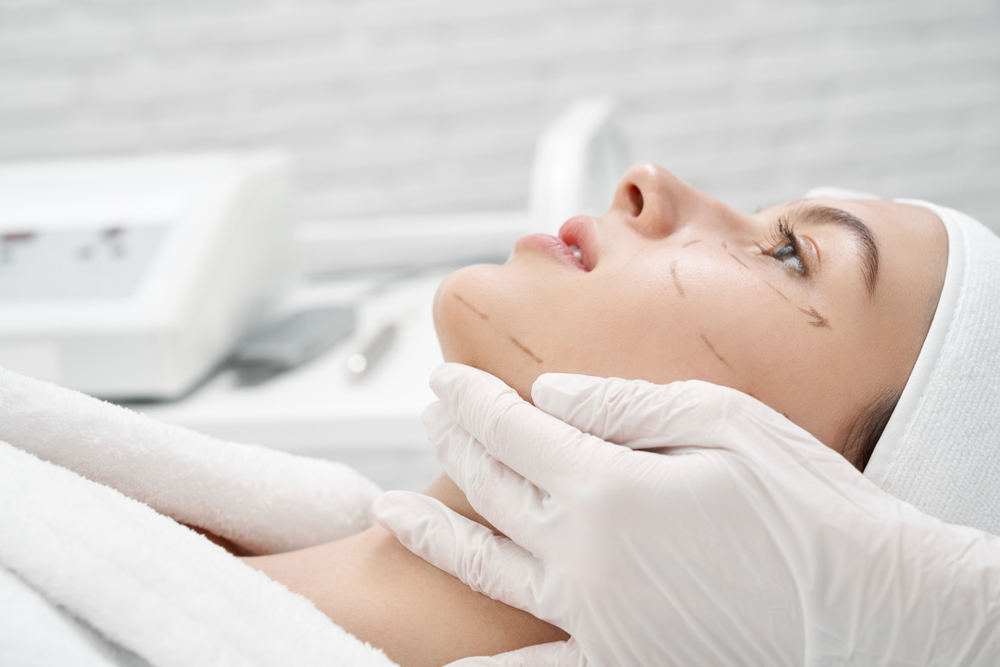The ability to engage and communicate with one another through our facial expressions makes facial plastic surgery potentially essential. How people see us depends on how we look. Some people are born with facial flaws like a cleft lip, a birthmark, or another congenital disability, while others would like to change important parts of their appearance. A skilled plastic surgeon can fix many things, like the effects of aging, sun damage, or injuries to the face.
Our expertise in medically-aesthetic face procedures allows us to provide our patients precisely what they want—a beautiful, natural look at the AZ Plastic Surgery Center.
At the moment, all kinds of solutions focus on the face. That is because the face is the most visible part of the body all year long, and sometimes you need to use specific techniques to fix the effects of age.
Different types of facial plastic surgeries
Some of the most common things that facial plastic surgeons do are:
- Nose surgery
- Neck lift
- Facelift
- Ear surgery
- Eyelid surgery
- Enlargement of the chin.
There are two basic categories of facial plastic surgery procedures: aesthetic or cosmetic surgery and reconstructive or restorative surgery.
Reconstructive And Restorative Surgery
Includes microsurgery, which is used to hide the effects of an accident or injury, birth defects, or tumors on the face.
Aesthetic Or Cosmetic Surgery
It is usually done on healthy people who want to change parts of their face that they don’t like so that they can live a better life. Some cosmetic procedures, like blepharoplasty, which helps people see better, or rhinoplasty, which makes it easier for people to breathe, can also be helpful in other ways.
What Is Involved In It?
How things are, will determine what needs to be done. First, the specialist surgeon will look at the patient’s condition and explain the options, such as what will happen before and after surgery and what the patient can expect.
During the process, the surgeon and patient must talk well with each other so that the patient knows what is going on, what risks are involved, and what the likely results will be.
How You Prepare For Facial Plastic Surgery

The specialist may give the patient tests before the surgery to check their health and ensure they are healthy enough to complete the procedure. Since each case is different, the type of anesthesia used, the length of the procedure, and the risks will also be different. The most likely outcomes of the visit are:
Medical History and Exam.
Get yourself ready to answer inquiries regarding your current and past health concerns. Describe any other surgery you’ve had, including cosmetic procedures. Remember to record any problems that have arisen as a result of prior surgical procedures. Inform the cosmetic surgeon whether you smoke, take drugs, or have alcohol problems.
Your capacity to undergo surgery may be questioned, prompting a referral to a specialist. The operating surgeon will do a physical examination of you. The surgeon might also ask your doctor for your medical history.
Medication Review.
Specify all the drugs you regularly use, along with their dosages. Include over-the-counter medications, those requiring a doctor’s prescription, and any herbal remedies, vitamins, and other nutritional supplements.
Facial Exam.
Your plastic surgeon will photograph your face from various perspectives, including close-ups of certain characteristics. Your surgeon will also evaluate your facial bones, form, fat distribution, and skin condition. The results of the examination will guide my recommendations for facial rejuvenation procedures.
Expectations.
Inquiries from your surgeon about your goals for the procedure are to be expected. The surgeon will discuss the anticipated results of your facelift. You will also discover the issues a cosmetic procedure cannot fix. Fine lines, wrinkles, and facial asymmetry are unaffected by a facelift.
Before a Facelift:
Follow medication directions.
Before your surgery, you will be given specific instructions on which drugs to stop taking and when to do so. You may, for instance, be instructed to discontinue the use of blood-thinning medications and supplements two weeks before surgery. Inquire whether medications can be used together or if your current dosage has to be changed.
Wash your face and hair.
Before your surgery, you will probably be instructed to use a germicidal soap to wash your hair and face.
Avoid eating.
On the night before your facelift, you won’t be able to eat or drink anything after midnight. Just water and drugs prescribed by your surgeon will be permitted.
Arrange for help during recovery.
If your facelift is an outpatient treatment, prepare for someone to take you home. After surgery, you’ll need assistance getting some rest the first night.
Risks Of Facial Plastic Surgery

Complications are possible with a facelift procedure. The symptoms of some conditions are amenable to treatment, either by medication or additional surgical intervention. Despite their rarity, long-term or chronic problems might lead to noticeable physical changes. Some of the dangers are:
Hematoma.
The most frequent issue following a facelift is the formation of a hematoma, a collection of blood under the skin. Swelling and pain are symptoms of a hematoma. Forming within the first 24 hours after surgery is not uncommon. Surgery performed quickly after the formation of a hematoma reduces the risk of permanent skin and tissue damage.
Scarring.
A facelift leaves behind lasting scars at the incision sites. Yet, they are usually unnoticeable due to the hairline and the shape of the face and ear. Scars with an elevated surface seldom occur after an incision.
Scars can sometimes be reduced in visibility by using injections of a corticosteroid medication or other therapies.
Nerve Injury.
It is unusual for nerves to be injured. Injuries to the nervous system can disrupt the function of the sensory or motor systems. The duration of this impact is unknown. Feeling numb or unable to move a facial muscle can be a temporary condition that lasts anywhere from a few months to a year. This could cause inconsistencies in facial expressions. The potential for amelioration by surgical intervention.
Hair Loss.
Hair loss at the incision sites is a possibility, both short- and long-term. Hair transplant surgery is an option for people with permanent hair loss.
Skin Loss.
Extreme caution must be taken during a facelift, as there is a small risk that blood flow to the face may be compromised. As a result, skin deterioration may occur. Medication and wound care are used to address skin loss. Scarring can be minimized through surgery if it becomes required.
The risks of a facelift are similar to those of any major operation, including the possibility of blood loss and infection. A negative reaction to the anaesthetic is also possible. Complications are more likely to occur if you have certain health issues or engage in certain behaviours.
There’s a chance that something bad will happen if the following happens. In these situations, your surgeon may advise against a facelift:
Blood-thinning Medications or Supplements.
Using blood-thinning drugs or supplements may alter the blood’s clotting capacity. Some examples of these pharmaceuticals are aspirin, nonsteroidal anti-inflammatory medicines (NSAIDs), ginseng, Ginkgo biloba, fish oil, and others that thin the blood or reduce inflammation. Following surgical procedures, they may raise the likelihood of hematomas.
Medical Conditions.
A facelift cannot be performed on someone who has a disease that inhibits blood from clotting. Slow wound healing, hematomas, and heart difficulties may all be caused by underlying medical issues. Diabetes and high blood pressure that isn’t managed well are two examples.
Smoking.
If you smoke, your facelift recovery will be slower, and you’re more likely to experience hematomas and skin loss.
Weight Changes.
Repeated weight gain and loss could make you unhappy with the surgery’s results in the long run. A person’s face and skin both change as their weight does.
What You Can Expect
A facelift may be performed in either an in-patient or out-of-hospital setting.
Before the procedure
Local anaesthesia (which numbs only a specific body area) and sedation may be used as an alternative to general anaesthesia. General anaesthesia, which induces a deep slumber, is used when this is not the case.
During the Procedure
In most cases, a facelift will tighten the facial muscles and tissues to lift the sagging skin. Sculpting, removing, or repositioning fat in the face and neck is possible. The skin of the face is redraped over the face’s new shapes. Excess skin is cut off, and the incision is either stitched or taped shut.
It is up to the surgeon performing the treatment and the patient to decide where and how extensive the incisions will be. Choices could involve:
- The incisions for a conventional facelift begin near the temples, just within the hairline. It curves behind the ears and back down to the ground. At the lower scalp, below the ears, it ends. It is possible to alter the look of your neck by having an incision made just under your chin.
- The hairline right above the ear is the starting point for a restricted incision, which means the incision will be shorter. It encircles the outer ear but stops short of reaching the scalp below.
- The incision for a neck lift often begins in the crease just in front of the ear. After going behind the ear, it reaches the base of the head. Under the chin, a similar incision is made.
Facelifts typically take between three and six hours. However, the process could take longer if combined with other cosmetic surgeries.
After the Procedure Of Facial Plastic Surgery

Some possible side effects of getting a facelift are:
- Mild to moderate pain
- Drainage from the incisions
- Swelling
- Bruising
- Numbness
If you have any of the following symptoms, you should see a doctor right away:
- Extreme discomfort on one side of the face or neck after surgery within the first 24 hours
- Pain in the chest
- Abnormal heart rhythms
Bandages will likely be placed over the wounds. Soft, even pressure from a bandage can help reduce swelling and bruise size. Sometimes, extra blood or fluid must be drained, and a tiny tube is inserted under the skin behind one or both ears.
During the initial postoperative period:
- Keep your head up while you relax.
- When your doctor prescribes pain medication, please take it as directed.
- Ice packs can be applied to the face to alleviate discomfort and minimise swelling.
Follow-up Appointments
In the two months after surgery, you will have several follow-up appointments. Among them are the following:
- The drainage tube will be taken out the day after surgery. The surgeon will likely re-bandage your face and apply antibiotic ointment to the incisions.
- In the days following a facelift, an elasticized facial sling is more comfortable than bandages.
- Once about a week has passed since the surgery, your doctor will examine the area and remove any stitches that were placed.
- To check up on your development later, subsequent visits will be organised.
Self-care
Reducing the likelihood of problems and speeding up the healing process, self-care at home should be prioritized during the first three weeks:
- The directions your surgeon gives you for caring for your wound must be followed by the letter.
- If a scab forms over your wound, resist the urge to pick at it.
- To avoid any potential complications, it’s important to use shampoo and soaps only once they’ve been approved for usage.
- Dress in front-closing items. Don’t wear anything that needs to be pulled over your head.
- Keep the incisions still and away from any vigorous movement.
- Try to go without cosmetics.
- Try to stay away from any activities that require a lot of aerobic effort.
- You should keep the incision out of direct sunlight for three weeks after the operation. Use sunscreen with at least a 30+ SPF rating going forward.
- Hair should be left untreated for at least six weeks after being dyed, bleached, or permed.
You may wear your hair in a particular way in the weeks following a facelift to conceal the scars. It’s understandable if you want to put off attending important social occasions for a while.
Care After The Procedure
Depending on the type of surgery, different things need to be done afterward. However, after most facial surgeries, you must rest for a while.
A common side effect of facial plastic surgery is swelling in the area where the surgery was done. As the inflammation goes away, it will take weeks or even months to see the full results.
How Should You Get Ready For Facial Plastic Surgery?
If you know what to expect from plastic surgery on your face, you will feel more at ease. Depending on you and your body, you could get sick, get a blood clot, get an infection, or have a bad reaction to the anesthesia. Also, if you smoke, you shouldn’t do it for two weeks before your surgery. That will help you heal better after your surgery.
Depending on their complexity, certain face surgeries can be performed outpatient. For some other systems, you may need to spend the night or one or two days in the hospital. Before you leave the hospital, your surgeon will talk to you about any special care you need to take at home while you heal. About a week after the surgery, the sutures, and surgical staples will be taken out in the office.
FAQ’s
What happens during plastic surgery on the face?
Plastic surgery on the face changes the shape of parts of the head and neck, usually the nose, ears, chin, cheeks, and neckline. People might want this surgery if they want to fix their faces after an accident or illness or if they want to change something that was there from birth.
Does plastic surgery on the face hurt?
Some people may say that plastic surgery is totally painless, but others may be in a lot of pain. Several things affect how much pain a patient feels after a treatment, which can help you figure out how much pain you’ll be in.
How long does it take to get better after surgery on the face?
Most people feel better between 4 and 6 weeks. But it will likely be at least 6 months before we can see how the surgery turned out. This care sheet gives you a general idea of how long it will take you to get better. But everyone gets better at different rates.
When is the best time to get plastic surgery on your face?
When signs of aging start to show, people in their 40s, 50s, and 60s are usually the best candidates for a facelift. Deep lines, wrinkles, fine lines, and bowed skin are all signs of aging. The best way to fix them is with surgery, not with non-surgical methods.
Can you smile after getting plastic surgery?
Most people can generally smile after one or two weeks, but it can take up to six weeks for some. The full effects of a facelift won’t be seen for about six months to a year.
What part of plastic surgery is the hardest?
In fact, most people think rhinoplasty is the hardest of all cosmetic operations.
Does plastic surgery on the face leave scars?
If you’ve been thinking about getting plastic surgery on your face, you might be worried about how the incision lines will look. Scarring is a natural part of the body’s healing process, which will always happen after cosmetic treatment.
What is the best treatment for a slim face?
- Facelift.
- Chin fat removal.
- Lip Lift. Botox.
- Lower Eyelid. Ultherapy.
What is the best treatment for the face?
People with less facial aging can look younger and fresher with a neck lift, forehead lift, mid-face lift, eyelid surgery, or chin surgery.
How safe is surgery on the face?
Plastic surgery is very safe, but all medical procedures have risks. This is true both during surgery and when the patient is getting better. Before you schedule a treatment that isn’t necessary, you should look into the qualifications of the doctor who will be doing it.
Is plastic surgery Good forever?
Even the effects of plastic surgery don’t last forever. Even though the surgery results may last longer than non-surgical treatments, most plastic surgery procedures still last from a few years to more than a decade.
Conclusion
In facial plastic surgery, the face’s underlying tissue and bone structure are reshaped or repositioned by incisions and specialist devices. To lessen the likelihood of complications and maximize the efficacy of the treatment, patients must be willing and able to adhere to all pre- and postoperative instructions strictly.


